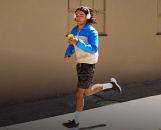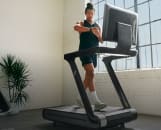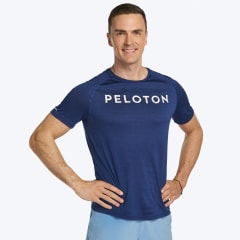
AzmanL/E+ via Getty Images
The 9 Best Beginner Arm Exercises, According to Experts
Want stronger arms? Start with these foundational exercises.
By Hillary Hoffower, Emily Laurence•
The Benefits of Arm Workouts
The Key Muscles In Your Arms
9 Arm Exercises for Beginners
How to Incorporate Beginner Arm Exercises Into Your Fitness Routine
Whether you’re going on a shopping spree or moving into a new place, having upper body strength is important for everything from carrying bags to lifting boxes. But it can take some time to build up those arm muscles and figure out where to start.
Even if you’re completely new to arm exercises, don’t be intimidated. “The good news about most arm exercises is that injuries are usually pretty rare with these compared to bigger compound movements like squats, bench presses, or deadlifts,” says Alex Corbett, a physical therapist at BreakThrough Physical Therapy. That’s great news for beginners.
Dr. Corbett and Peloton instructor Ben Alldis explain everything you need to know about arm exercises for beginners below, including the best exercises they recommend you start with.
The Benefits of Arm Workouts
Having strong arms can make everyday tasks that much easier and help with cross training, says Ben. He breaks down five key benefits:
They help you become a stronger athlete. Building upper body strength makes exercises like push-ups, pull-ups, overhead presses, and rowing easier. Ben says this will likely improve the efficiency of your training sessions. Never tried these moves before? Starting with arm exercises for beginners will make them easier to attempt when you’re ready.
They improve functional movements by helping with everyday tasks that involve lifting, carrying, and pushing.
They increase sports performance for athletes of all levels. “Many sports require upper body strength and power,” Ben says. Stronger arms can provide a competitive advantage for rock climbing, swimming, tennis, basketball, and martial arts by “enhancing your ability to generate force, control movements, and improve performance.”
They help prevent injuries by stabilizing and protecting the shoulders, elbows, and wrists. This can reduce the risk of common injuries such as shoulder impingement, tennis elbow, and wrist strains.
But “it's essential to focus on following a balanced training schedule that targets all muscle groups rather than solely emphasizing arm strength,” Ben says, adding that incorporating leg, core, and cardio workouts will help you build your overall fitness and prevent muscle imbalances.

Peloton App
Access thousands of classes with no equipment needed.
The Key Muscles In Your Arms
The muscles you’ll be strengthening fall into three key groups, explains James Higgins, physical therapist and co-owner of Integrative Physical Therapy of NYC:
The deltoids, or shoulder muscles: These allow the entire arm to flex, abduct, extend, and rotate internally or externally, helping with everything from reaching objects in high cabinets to lifting a heavy barbell overhead.
The elbow flexors, or biceps: These bend the forearm toward the shoulder, assisting with “pulling activities” like opening doors and pull-ups.
The elbow extensors, or triceps: These straighten out the forearm away from the shoulder, helping with “pushing activities” like getting off the ground and burpees.
“When exercising these three muscle groups, you’re training your body to perform everyday movements and aiding the performance of difficult exercises,” Higgins says.
But don’t overtrain them. Regular muscle soreness lasts 24 to 48 hours post-workout; if soreness lasts beyond this period, he advises avoiding training them until it subsides. Rest, hot and ice packs applied for 15 minutes max, and compression sleeves can help expedite the recovery process.
9 Arm Exercises for Beginners
Are you ready to start your arm workout routine? Ben and Dr. Corbett share nine exercises that cover the three arm muscle groups, and then some.

1. Bicep Curls
As far as arm exercises for beginners go, Ben says that bicep curls are great to start with because they build bicep, tricep, and grip strength all in one move.
Hold dumbbells with an underhand, shoulder-width grip by your sides.
Exhale, curling weight to chest, and keeping upper arms stationary with your elbows at your sides.
Lower back to starting position.
To make it more advanced, use heavier weights or slow down each rep to increase time under tension.

2. Bent Over Row
This move builds strong back muscles by engaging your lats, traps, and rhomboids. It also uses the back, glutes, and legs to stabilize the body. “Building a strong back and posterior chain is important for improving posture and overall strength,” Ben says.
Hold a dumbbell in one hand with your arm relaxed by your side and your feet shoulder-width apart.
Hinge at your hips to create a 60-degree angle, keeping your back flat and core engaged.
Pull the dumbbell up and back, keeping your elbow tucked into your body.
Lower the dumbbell back down with control.
To make it more advanced, use a dumbbell in each hand at the same time. You can also squeeze your shoulder blades together or hold the weights at the top.

3. Triceps Kickbacks
Ben says that triceps kickbacks are a great arm exercise for beginners because they’re easy to master and hard to mess up!
Stand with a dumbbell in each hand, facing palms inward.
Hinge at the hips, maintaining a flat back, while rowing the weights back to bring your bent elbows backward. Tuck arms in close to your midline. This is your starting position.
Extend both arms out long to kick the weights back without overextending your elbow joint.
Engage your triceps at the top. Return to a 90-degree angle.
To make it more advanced, do triceps pulses and holds.

4. Push-Ups
Even if you’ve never picked up a dumbbell before, there’s a good chance you’ve at least attempted a push-up, an exercise move that works the triceps, anterior deltoids, and core muscles. They can help build upper body strength and improve overall body composition.
Begin in a plank position, with your hands stacked below your shoulders, gaze on the floor, and your spine neutral.
Squeeze your shoulders, glutes, and core to create full-body tension.
Bend your elbows to move toward the floor until they reach a 45-degree angle relative to the torso.
Maintain the tension as you push back up off the floor to your original position, with your arms fully extended.
To make it easier, place your hands on a bench instead of the floor. Then, progress to your knees before doing a classic off-the-knees push-up, which Ben says “can take time and commitment to master.”

5. Shoulder Press
This is one of the best arm exercises for beginners for strengthening your shoulders and upper back, as it works out the front portion of your shoulder muscle, plus your deltoids, triceps, trapezius, and pecs.
Begin kneeling or standing. Hold a dumbbell in each hand at shoulder height, with your palms facing forward.
Press the dumbbells up, fully extending your arms without locking out your elbows.
Lower the dumbbells back to shoulder height, maintaining a stable core and straight back throughout.
To advance this exercise, use strict form to ensure you’re working the shoulder to the max.

6. Lateral Raise
This move, which is perfect for beginners, works the lateral deltoid muscles. You’ll also use your front deltoids and upper traps thanks to the rotating movement of the exercise.
Stand upright with a dumbbell in each hand. Keep your arms straight down at your sides with your palms facing your body.
Bring the dumbbells straight out to the sides of your body so that your arms form the letter T. Keep your core and glutes tight. Squeeze your shoulder blades together. Keep your chest up.
Pause at the top, when your arms are parallel to the ground.
Slowly lower your arms back down to your sides.
To advance this exercise, add in holds at the top to challenge the muscles.
7. Cable Lateral Raise
Cable lateral raises are one of Dr. Corbett’s favorite arm exercises for beginners. They are similar to dumbbell lateral raises and are done using a cable machine. In addition to targeting your arm, Dr. Corbett says that you’ll feel it working your shoulders too.
When deciding how much weight to use, start with one offering low resistance. This will give you an opportunity to master the form first. Once you’re comfortable with the move, you can increase the weight.
Stand to the left of the cable rack and hold the handle with your left hand.
Lift your left hand, keeping a slight bend in your left elbow. Your abs should be engaged.
Once your elbow is about shoulder height, pause and lower your hand down to the starting position.
Do 8 to 12 reps. Then, repeat with your other arm.
8. Triceps Cable Press Down
While you’re at the cable machine, give this exercise a try. “This move effectively targets the triceps and is very easy to set up and progress in weight,” Dr. Corbett says, of why he recommends triceps cable press downs as a beginner arm exercise.
Stand facing the cable machine, with your elbows tucked at your sides.
Hold the cable bar and stand with your feet slightly apart.
Push down until your arms are fully extended, keeping your elbows to your sides. Your back should be straight the entire time and your knees should be slightly bent.
Come back to the starting position. Do three sets of 8 to 12 reps.

9. Chin-Ups
Chin-ups target the biceps as well as the upper back, Dr. Corbett explains. While still challenging, they’re easier than pull-ups, making them a good arm exercise for beginners.
Stand under the chin-up bar. If you can’t reach it easily, stand on a stool or block.
Grab the bar with your palms facing you.
Lift your body until your chin is over the bar and your feet are dangling.
Hold for as long as you can and then gently come back to the floor.
How to Incorporate Beginner Arm Exercises Into Your Fitness Routine
When you’re first starting out, Dr. Corbett recommends starting with just a few reps per exercise and gradually increasing it. “Starting with too much volume before your muscles and tendons can acclimate will sometimes lead to pain,” he says. Ben explains that starting with lighter weights allows you to perfect your form first, which is crucial. Once you feel confident performing the move, then you can decide on your reps and weights.
If building arm strength is one of your primary fitness goals, Dr. Corbett recommends adding arm exercises to the very beginning of your workout. “Beginners often hit arms once or twice a week, but these smaller muscle groups such as the biceps and middle delts can actually handle a higher frequency because they recover faster,” Dr. Corbett says. Because of this, he says that doing arm exercises up to four times a week is okay. “For beginners, I recommend hitting each arm muscle group three times per week, with around two to four sets per workout,” he says.
Ben says many beginners don’t progress their weights enough after they have their form and technique locked down. Here’s his guide once you do.
If You Want to Build Strength and Increase Power: Low Reps, Heavy Weight
“This stimulates the development of fast-twitch muscle fibers, which are responsible for generating force and power,” Ben says. "By lifting heavier weights with fewer repetitions, you can challenge and overload your muscles, promoting strength gains.”
If You Want to Build Muscular Endurance and Improve Overall Fitness: High Reps, Light Weight
“This focuses on slow-twitch muscle fibers, which are involved in sustained, repetitive movements,” Ben explains. “By performing more repetitions with lighter weights, you can enhance muscular endurance and improve cardiovascular fitness.”
Remember, you’re often stronger in some parts of your body than others, so each exercise may require a slightly different weight. “Listening to your body and swapping out weights as needed is key as you build muscle and do strength training more regularly,” Ben says.
He advises focusing on each muscle group at least twice a week, assigning two to three specific days for arms. So if you follow an upper/lower body split, you can dedicate one or two upper body days solely to arm exercises. This gives your muscles sufficient time to recover and rebuild, he says. And make sure you warm up and cool down to avoid injury and aid in the recovery process.
Ben’s The Stronger You and The Stronger You 2 Programs offer a four week, four days a week program, which includes an upper workout, a lower workout, and two full body days. You can also check out the Arms With Tunde Program which features three arm workouts a week. “Doing this program alongside some lower body strength training and/or cardio classes would be a great training split,” Ben says.
Related Articles
This content is for informational and educational purposes only and does not constitute individualized advice. It is not intended to replace professional medical evaluation, diagnosis, or treatment. Seek the advice of your physician for questions you may have regarding your health or a medical condition. If you are having a medical emergency, call your physician or 911 immediately.
Level up your inbox.
Subscribe for a weekly dose of fitness, plus the latest promos, launches, and events.
By providing your email address, you agree to receive marketing communications from Peloton.
For more about how we use your information, see our Privacy Policy.











